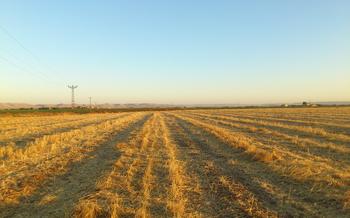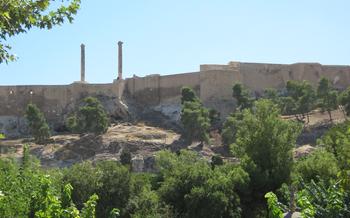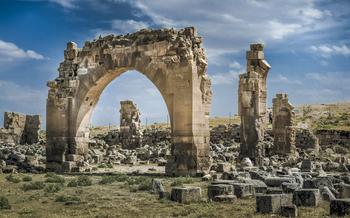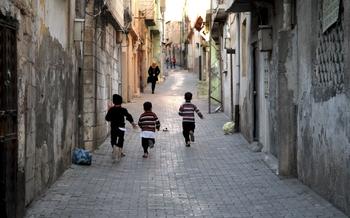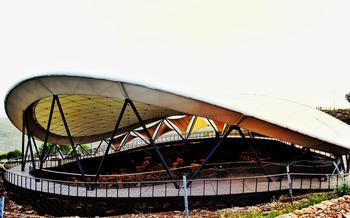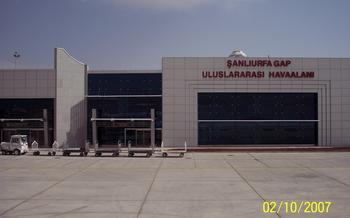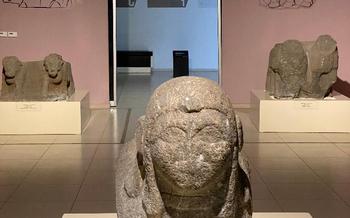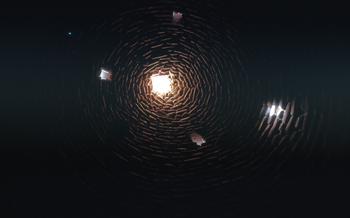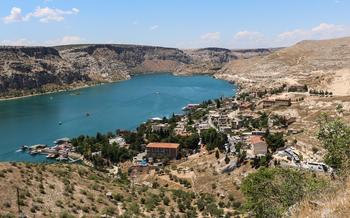
Han El Ba'rur
- The Palace of Rumkale
- Historical Significance
- Architectural Features
- Location and Accessibility
- Must-See Spots
- Göbekli Tepe
- Harran Beehive Houses:
- Historical Context:
- Cultural Significance:
- Preservation Efforts:
- Balıklıgöl (Fish Lake)
- Şanlıurfa Castle: A Majestic Fortress Overlooking the City
- Eyyubi Mosque
- Urfa Bazaar: A Culinary and Cultural Delight
- Halfeti Village
- A Place of Beauty and Historical Significance
- Birecik Bridge: A Masterpiece of Engineering and History
- Harran University
- Şanlıurfa Cuisine
- Traditional Crafts and Handicrafts
- Kurşunlu Mosque: A Hidden Gem in Şanlıurfa
- Insider Tip:
The Palace of Rumkale
The Palace of Rumkale, also known as the Citadel of Rumkale, stands as a testament to the rich history and architectural prowess of Şanlıurfa. Perched atop a rocky promontory overlooking the Euphrates River, this awe-inspiring fortress has borne witness to the rise and fall of civilizations for centuries.
Historical Significance
The palace's origins can be traced back to the 6th century AD, when it was constructed by the Byzantines as a strategic military outpost. Over the centuries, it served as a stronghold for various empires, including the Romans, Arabs, Crusaders, and Ottomans. Each civilization left its unique mark on the palace, contributing to its diverse architectural heritage.
Architectural Features
The Palace of Rumkale boasts an impressive array of architectural features that reflect the diverse influences that shaped its history. Its massive stone walls, fortified with towers and gateways, showcase the defensive prowess of its Byzantine builders. The interior reveals a labyrinth of chambers, courtyards, and tunnels, hinting at the palace's former grandeur.
Location and Accessibility
The Palace of Rumkale is situated approximately 50 kilometers southwest of Şanlıurfa, in the Halfeti district. Its strategic location on the banks of the Euphrates River made it a crucial transportation hub and a focal point for trade and commerce throughout history. Today, visitors can easily reach the palace by road or take a scenic boat trip along the river to admire its imposing facade from a unique perspective.
Must-See Spots
Among the must-see spots within the Palace of Rumkale are the Byzantine chapel, with its intricate frescoes and mosaics, the Ottoman baths, a testament to the empire's lavish lifestyle, and the panoramic terraces that offer breathtaking views of the surrounding countryside. The palace's rich history and captivating atmosphere make it a must-visit destination for anyone seeking to delve into the cultural heritage of Şanlıurfa.
Göbekli Tepe
Across the landscape of Şanlıurfa, one finds the wonders of Göbekli Tepe, an archaeological site of immeasurable significance. Embark on a journey through time as you explore its enigmatic ancient structures, monolithic pillars, and intricate carvings.
Göbekli Tepe holds a remarkable distinction as one of the oldest known religious sites in the world, predating the Great Pyramids of Egypt and Stonehenge by several millennia. As you stand among these colossal megaliths, marvel at the ingenuity of our ancestors and contemplate the secrets they hold.
A true testament to human ingenuity, Göbekli Tepe's importance in archaeology cannot be overstated. Its discovery has revolutionized our understanding of the origins of human civilization and religion. Through careful excavation and research, archaeologists have uncovered a treasure trove of artifacts and insights, providing invaluable clues into the lives and beliefs of our distant past.
Theories and interpretations abound as scholars seek to unravel the mysteries of Göbekli Tepe. Some believe it served as a sacred gathering place for ritualistic practices, while others propose that it functioned as an astronomical observatory, aligning with celestial events. Whatever its purpose, one thing is certain: Göbekli Tepe offers a glimpse into a world that existed long before recorded history.
As a UNESCO World Heritage Site, Göbekli Tepe beckons travelers from around the globe to witness its wonders. Immerse yourself in its ancient aura and let your imagination soar as you ponder the secrets this extraordinary site holds.
Harran Beehive Houses:
Amidst the vast plains of Şanlıurfa lies a remarkable village that has stood the test of time - Harran. This ancient settlement is renowned for its iconic beehive houses, a unique architectural marvel that has captivated the imaginations of travelers and historians alike.
Historical Context:
The beehive houses of Harran have a rich historical background, dating back to the 3rd millennium BC. They were initially constructed by the Hurrians and later adopted by other civilizations that inhabited the region. The unique shape of these dwellings, resembling upside-down beehives, was designed to provide shelter from the harsh weather conditions of the Mesopotamian desert.
Cultural Significance:
The beehive houses hold immense cultural significance for the people of Harran. They are not merely structures but embodiments of the region's cultural heritage. The construction techniques, materials, and designs reflect the ingenuity and resilience of the ancient inhabitants. These dwellings have been passed down from one generation to another, serving as a reminder of the village's deep-rooted traditions and way of life.
Preservation Efforts:
In recent years, there has been a growing awareness of the historical importance of Harran's beehive houses. Concerted efforts have been made to preserve and restore these unique structures. The local government, in collaboration with international organizations, has initiated projects to document, maintain, and protect these architectural treasures. By doing so, they aim to ensure that future generations can continue to appreciate and learn from this remarkable aspect of Harran's cultural heritage.
Balıklıgöl (Fish Lake)
At the heart of Şanlıurfa lies the sacred site of Balıklıgöl, or Fish Lake, a revered destination steeped in religious significance. Legend has it that Prophet Abraham, upon being thrown into a fire by Nimrod, was miraculously saved when the flames turned into water and the burning logs transformed into carp fish. As a testament to this divine intervention, the lake is teeming with carp, considered sacred and revered by the locals, who often feed them as an act of devotion.
Beyond its religious importance, Balıklıgöl is a place of tranquility and beauty, where visitors can lose themselves in the serene atmosphere and admire the picturesque surroundings. The lake is dotted with historical landmarks, including the Halil-ur Rahman Mosque, believed to be the birthplace of Prophet Abraham, and the Rizvaniye Mosque, renowned for its exquisite architecture.
For those seeking spiritual enlightenment, Balıklıgöl offers a unique opportunity to immerse themselves in the rich history and traditions of the region. Whether seeking solace or simply marveling at the beauty of the sacred site, visitors to Şanlıurfa should not miss the chance to visit Balıklıgöl, a place where faith, history, and natural beauty converge.
Şanlıurfa Castle: A Majestic Fortress Overlooking the City
Şanlıurfa Castle stands as a testament to the city's rich history and strategic importance. Perched atop a hill overlooking the city, this formidable fortress has guarded Şanlıurfa for centuries. Its imposing walls and towers have witnessed countless battles and sieges, serving as a symbol of resilience and strength.
The castle's origins can be traced back to the Roman era, when it was constructed as a military outpost to protect the region from invading forces. Over the centuries, it underwent several renovations and expansions, reflecting the changing rulers and architectural styles. The Byzantines, Seljuks, and Ottomans all left their mark on the castle, contributing to its unique blend of architectural influences.
Today, Şanlıurfa Castle stands as a magnificent example of medieval fortification. Its massive walls, punctuated by sturdy towers, enclose a sprawling courtyard that once housed barracks, stables, and other military facilities. Visitors can explore the castle's ramparts and climb to the top of the towers to enjoy breathtaking panoramic views of the city and the surrounding countryside.
In recent years, the castle has undergone extensive restoration and preservation efforts, ensuring its continued existence for generations to come. The restoration work has not only preserved the castle's historical integrity but also transformed it into a vibrant cultural center. The courtyard now hosts concerts, exhibitions, and other events, bringing the castle to life and making it a popular gathering place for locals and visitors alike.
Şanlıurfa Castle is not just a historical monument; it is a living symbol of the city's proud heritage. Its imposing presence and rich history make it a must-visit attraction for anyone interested in exploring the cultural tapestry of Şanlıurfa.
Eyyubi Mosque
The Eyyubi Mosque, also known as the Halil-ur-Rahman Mosque, stands as a testament to the religious and architectural heritage of Şanlıurfa. Built in the 13th century during the reign of the Ayyubid dynasty, this grand mosque holds immense spiritual significance for Muslims worldwide.
Architectural Style and Significance:
The Eyyubi Mosque showcases a blend of Seljuk and Gothic architectural styles, reflecting the diverse influences that shaped the region's history. Its towering minaret, intricate stone carvings, and elegant domes create a striking visual ensemble. The mosque's interior features a spacious prayer hall adorned with colorful tiles, chandeliers, and a beautifully crafted mihrab (prayer niche) indicating the direction of Mecca.
Religious Importance:
The Eyyubi Mosque is believed to be built on the site where Prophet Abraham was thrown into a fire by King Nimrod for refusing to worship idols. According to Islamic tradition, God miraculously turned the fire into water and saved Abraham, earning the site its name "Halil-ur-Rahman," meaning "Friend of the Merciful." This sacred association attracts numerous pilgrims and visitors to the mosque throughout the year.
Historical Context:
The Eyyubi Mosque stands as a testament to the rich history of Şanlıurfa, a city that has been a crossroads of civilizations for centuries. It has undergone several renovations and expansions over the years, reflecting the changing political and cultural landscapes of the region. The mosque's current form dates back to the 19th century, when it was extensively restored and enlarged during the Ottoman period.
Surrounding Landmarks:
The Eyyubi Mosque is conveniently located in the heart of Şanlıurfa, surrounded by several other historical and cultural landmarks. Visitors can explore the nearby Şanlıurfa Castle, the Grand Bazaar, and the Cave of Abraham, all within walking distance. This proximity allows for a comprehensive exploration of the city's rich heritage and religious significance.
Urfa Bazaar: A Culinary and Cultural Delight
Urfa Bazaar is a vibrant marketplace that captures the essence of Şanlıurfa's local flavor and rich cultural heritage. This bustling bazaar is a shopper's paradise, offering a treasure trove of traditional products, from exquisite handmade crafts to aromatic spices and delectable local delicacies.
As you wander through the labyrinthine alleys of the bazaar, your senses will be tantalized by the alluring scents of freshly baked bread, roasted coffee beans, and sizzling kebabs. Indulge in the culinary delights of Şanlıurfa, savoring the flavors of traditional dishes like "şıllık" (stuffed grape leaves) and "lahmacun" (Turkish pizza). Don't miss the chance to taste the world-famous Şanlıurfa kebabs, renowned for their unique blend of spices and tender meat.
Street food stalls line the narrow streets, offering a variety of local delicacies to satisfy every palate. Sample the crispy "künefe" (shredded pastry with cheese and syrup) or the sweet "katmer" (layered pastry filled with nuts and honey).
Embrace the local tradition of bargaining as you interact with the friendly vendors. With a smile and a bit of negotiation, you can secure the best prices for the treasures you find.
Immerse yourself in the vibrant atmosphere of Urfa Bazaar, where the air is filled with the sounds of haggling, the clinking of coins, and the hum of daily life. Experience the warmth and hospitality of the local people as they welcome you to their vibrant marketplace.
Halfeti Village
A Place of Beauty and Historical Significance
Halfeti Village, located on the banks of the Euphrates River, is a captivating destination that draws visitors with its unique charm and historical significance.
The village is renowned for its Black Roses, a rare species found exclusively in this region. These roses, with their velvety dark petals, bloom in abundance during the spring, creating a breathtaking sight that attracts nature enthusiasts and photographers alike.
Boat tours are a popular way to explore the village and its surroundings, offering panoramic views of the river and the lush green landscapes. Visitors can also admire the traditional mud-brick houses that line the riverbanks, a testament to the region's rich cultural heritage.
The warm hospitality of the locals adds to the allure of Halfeti. Visitors are welcomed with open arms and invited to experience the village's unique way of life. From traditional cuisine to local customs, there is much to discover and appreciate in this hidden gem of Şanlıurfa.
Birecik Bridge: A Masterpiece of Engineering and History
Birecik Bridge, an architectural marvel spanning the majestic Euphrates River, stands as a testament to human ingenuity and engineering prowess. Constructed in the 6th century AD, this ancient bridge has played a pivotal role in connecting the regions of Şanlıurfa and Gaziantep, facilitating trade, travel, and cultural exchange.
With its impressive length of over 150 meters and 22 arches, Birecik Bridge is a masterpiece of Roman engineering. Its sturdy construction has withstood the test of time, enduring floods, earthquakes, and countless battles. The bridge's unique design, featuring pointed arches supported by massive piers, allowed for efficient water flow and reduced the risk of structural damage during flooding.
Beyond its engineering significance, Birecik Bridge holds immense historical value. It served as a vital artery for the movement of armies, pilgrims, and merchants throughout the centuries. The bridge was a key point of contention during the Roman-Persian Wars and was later used by Arab and Ottoman armies. Its strategic location made it a target of conquest, and it changed hands several times over the centuries.
Today, Birecik Bridge stands as a symbol of unity and connection between the people of Şanlıurfa and Gaziantep. It has been carefully restored and preserved, allowing visitors to marvel at its architectural grandeur and historical significance. While crossing this ancient bridge, one can't help but feel a sense of awe and appreciation for the skill and determination of those who built it so many centuries ago.
In addition to its engineering and historical significance, Birecik Bridge offers breathtaking views of the surrounding landscape. From the bridge, visitors can gaze upon the meandering Euphrates River, lush green fields, and distant mountains. It's a perfect spot to capture stunning photographs and simply soak in the tranquility of the natural surroundings.
When visiting Şanlıurfa, make sure to include Birecik Bridge in your itinerary. This architectural wonder is a must-see for anyone interested in history, engineering, or simply appreciating the beauty of ancient structures. The bridge is easily accessible by road, and there are several nearby attractions worth exploring, such as the ancient city of Halfeti and the Rumkale Castle.
Harran University
Şanlıurfa is not only known for its ancient history and cultural heritage but also for its contribution to modern education and research. Harran University, established in 1992, has become a prominent center of higher learning in the region. With its state-of-the-art campus, dedicated faculty, and diverse academic programs, Harran University has been instrumental in shaping the educational landscape of Şanlıurfa.
The university's modern campus is a testament to its commitment to providing students with a conducive learning environment. It houses well-equipped classrooms, modern laboratories, and an extensive library. Harran University offers a wide range of undergraduate and graduate programs across various disciplines, including engineering, medicine, social sciences, and humanities.
In addition to its academic pursuits, Harran University is actively involved in cultural and research activities. The university regularly hosts conferences, seminars, and exhibitions that bring together scholars, researchers, and students from around the world. It also boasts several research centers and institutes that focus on areas of regional and global significance, such as the Center for Archaeological Research and the Institute for Kurdish Studies.
Harran University's commitment to academic excellence and research has earned it a reputation for producing highly skilled and knowledgeable graduates. Its alumni have gone on to successful careers in various fields, contributing to the development of Şanlıurfa and beyond.
Whether you are a prospective student, a researcher, or simply someone interested in exploring the vibrant academic scene of Şanlıurfa, Harran University is worth a visit. Its modern campus, diverse academic offerings, and commitment to research make it a valuable asset to the city and the region.
Şanlıurfa Cuisine
Şanlıurfa, a city steeped in history and culture, boasts a rich and diverse culinary tradition that reflects its unique geographical location and the influences of various civilizations that have passed through the region. The city's cuisine is known for its bold flavors, aromatic spices, and fresh ingredients, creating a symphony of tastes that will tantalize your palate.
One of the must-try dishes in Şanlıurfa is the legendary Urfa kebab, a succulent grilled meat dish made from minced lamb or beef, seasoned with a blend of spices and herbs, and served with grilled tomatoes, peppers, and onions. The kebab is often accompanied by Şanlıurfa's famous lahmacun, a thin, crispy flatbread topped with minced meat, tomatoes, and spices.
For a taste of traditional Şanlıurfa cuisine, head to one of the many local restaurants that specialize in Urfa kebab and lahmacun. These restaurants, often family-run and passed down through generations, offer an authentic dining experience and the opportunity to interact with the locals.
In addition to these iconic dishes, Şanlıurfa is also known for its delicious appetizers, known as meze. These small plates, served before the main course, offer a variety of flavors and textures, from creamy hummus and tangy pickles to crispy falafel and grilled halloumi cheese.
No meal in Şanlıurfa is complete without a cup of salep, a warm and comforting drink made from orchid roots, milk, and sugar, often flavored with cinnamon or cocoa. Şanlıurfa is also famous for its sweet treats, such as künefe, a shredded wheat pastry filled with melted cheese and topped with syrup, and katmer, a flaky pastry filled with nuts and honey.
To fully immerse yourself in the culinary delights of Şanlıurfa, visit the city's vibrant markets, where you can find fresh produce, spices, and local delicacies. The Urfa Bazaar is a particularly popular spot, where you can browse stalls selling everything from traditional Turkish delight to hand-woven carpets.
Whether you're a foodie or simply enjoy trying new and exciting flavors, Şanlıurfa is a culinary paradise waiting to be explored. So, come hungry and prepare to be amazed by the city's rich and diverse cuisine.
Traditional Crafts and Handicrafts
Şanlıurfa is renowned for its vibrant tradition of handicrafts, where skilled artisans create exquisite works of art that reflect the city's rich cultural heritage. Visitors can immerse themselves in the bustling workshops, where the sounds of hammers and chisels mingle with the warm smiles of local artisans.
Handcrafted Carpets: The city is particularly famous for its intricate carpets, meticulously crafted using traditional techniques passed down through generations. These vibrant carpets depict mesmerizing patterns and motifs, each telling a unique story. Visitors can witness the artisans' nimble fingers as they weave colorful threads, creating masterpieces that adorn homes and palaces alike.
Pottery and Ceramics: Şanlıurfa's potters have mastered the art of transforming humble clay into exquisite pottery and ceramics. From intricately painted vases to ornate plates, each piece showcases the artisans' creativity and skill. The vibrant colors and delicate designs reflect the city's vibrant energy, making these ceramics cherished souvenirs.
Metalwork and Jewelry: The city's metalworkers create intricate jewelry and decorative items, showcasing their expertise in shaping metals into beautiful forms. From shimmering earrings to ornate necklaces, each piece is a testament to the artisans' mastery. Visitors can witness the transformation of raw metal into wearable art, a testament to Şanlıurfa's rich craftsmanship.
Shopping for Souvenirs: The traditional bazaar in Şanlıurfa is a treasure trove of handcrafted souvenirs. Visitors can browse the colorful stalls, where artisans display their latest creations. From intricately woven carpets to delicate pottery and shimmering jewelry, there's something to suit every taste and budget.
Şanlıurfa's traditional crafts offer a glimpse into the city's rich cultural heritage. Whether you're an art enthusiast, a passionate collector, or simply seeking a unique souvenir, the city's artisans are ready to welcome you into their world of creativity and craftsmanship.
Kurşunlu Mosque: A Hidden Gem in Şanlıurfa
Amidst the many architectural wonders of Şanlıurfa, the Kurşunlu Mosque stands as a lesser-known gem, waiting to be discovered. Built in the 12th century during the Artuqid period, this mosque is a testament to the city's rich history and cultural heritage.
The Kurşunlu Mosque showcases a unique architectural style that blends Seljuk and Armenian influences. Its most distinctive feature is its lead-covered dome, which gives the mosque its name, as "kurşun" means "lead" in Turkish. The dome's intricate geometric patterns and turquoise color create a striking visual contrast against the mosque's sandstone exterior.
Inside the mosque, visitors are greeted by a serene and spacious prayer hall, supported by massive stone columns. The walls are adorned with beautiful calligraphy and intricate tilework, showcasing the artistry of the period. The mihrab, or prayer niche, is particularly noteworthy for its delicate carvings and colorful tiles.
Despite its historical significance, the Kurşunlu Mosque often goes unnoticed by tourists, making it a hidden gem waiting to be explored. Located in the historic district of Şanlıurfa, the mosque is easily accessible on foot from other major attractions.
Whether you are a history buff, an architecture enthusiast, or simply looking for a peaceful retreat, the Kurşunlu Mosque is a must-visit destination in Şanlıurfa. Its unique architectural style, historical significance, and serene atmosphere make it a hidden gem that should not be missed.
Insider Tip:
Şanlıurfa is best experienced in the shoulder months (April-May and September-October) when the weather is pleasant and the crowds are smaller. Respect local customs and dress modestly, especially when visiting religious sites. Şanlıurfa is easily accessible by air, with direct flights from major cities in Turkey. Once in the city, the public transportation system is efficient and affordable. For a unique experience, take a local dolmuş (shared minibus) to explore the city's neighborhoods.
Don't miss the hidden gems of Şanlıurfa, such as the Siverek Castle, located about an hour's drive from the city center. This impressive castle offers stunning views of the surrounding countryside. Another off-the-beaten-path attraction is the Harran Plain, home to the ancient city of Harran and its iconic beehive houses. Explore this fascinating region and discover its rich history and culture.
